
The ide, or orfe, is a freshwater fish of the family Cyprinidae found in larger rivers, ponds, and lakes across Northern Europe and Asia. It has been introduced outside its native range into Europe, North America, and New Zealand. It is a popular ornamental fish, usually kept in outdoor ponds in temperate regions from which it often escapes.

The Antarctic toothfish is a large, black or brown fish found in very cold (subzero) waters of the Southern Ocean near Antarctica. It is the largest fish in the Southern Ocean, feeding on shrimp and smaller fish, and preyed on by whales, orcas, and seals. It is caught for food and marketed as Chilean sea bass together with its sister species, the more northerly Patagonian toothfish. Often mistakenly called "Antarctic cod", the Antarctic toothfish belongs to the notothen family (Nototheniidae), a group of fish species abundant near Antarctica.
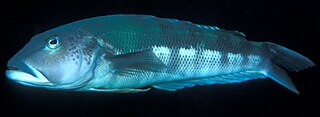
The New Zealand blue cod is a temperate marine fish of the family Pinguipedidae. It is also known by its Māori names, rāwaru, pākirikiri and patutuki, and by its other names in English, Boston blue cod, New Zealand cod or sand perch.
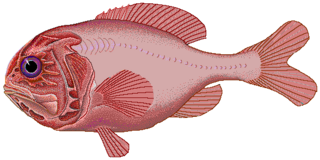
The orange roughy, also known as the red roughy, slimehead and deep sea perch, is a relatively large deep-sea fish belonging to the slimehead family (Trachichthyidae). The UK Marine Conservation Society has categorized orange roughy as "vulnerable to exploitation". It is found in 3 to 9 °C, deep waters of the Western Pacific Ocean, eastern Atlantic Ocean, Indo-Pacific, and in the eastern Pacific off Chile. The orange roughy is notable for its extraordinary lifespan, attaining over 200 years. It is important to commercial deep-trawl fisheries. The fish is a bright, brick-red color, fading to a yellowish-orange after death.

Arripis is a genus of marine fishes from Australia and New Zealand, known as Australian salmon, kahawai and Australian herring. They are the only members of the family Arripidae. Despite the common name, Australian salmon are not related to the salmon family Salmonidae of the Northern Hemisphere, just as Australian herring are not related to herring of the Northern Hemisphere, but belong to the order Perciformes of perch-like fishes. Australian salmon were named so by early European settlers after their superficial resemblance to the salmoniform fishes.

The porae, the grey morwong, blue morwong, butterfish, Douglas' morwong, Eastern blue morwong, great perch, queen snapper, rubberlip morwong or silver morwong, is a species of marine ray-finned fish, traditionally regarded as belonging to the family Cheilodactylidae, the members of which are commonly known as morwongs. It is found around south eastern Australia and the north eastern coast of the North Island of New Zealand at depths of about 10 to 100 metres, on sandy and rocky coasts.

Hyporhamphus ihi, the known as the garfish, piper or by its Māori name takeke, is a halfbeak found all around New Zealand in shallow inshore waters.
The pink cusk-eel, Genypterus blacodes, is a demersal species of cusk-eel found in the oceans around southern Australia, Chile, Brazil, and around New Zealand except the east coast of Northland, in depths of 22 to 1,000 metres. Their length is up to 200 centimetres, and they live for up to 30 years. Their maximum weight is 25 kilograms.

The hāpuku, hapuka or whapuku, also known as groper, is a wreckfish of the family Polyprionidae, found around southern Australia, southern South America, South Africa, Tristan da Cunha and New Zealand at depths between 30 and 800 m. Its length is between 60 and 180 cm, and it can weigh up to 100 kg. It is sometimes described locally as cod, although that properly refers to other fish.
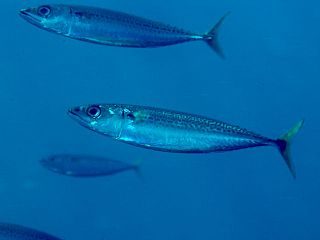
The blue mackerel, also called Japanese mackerel, Pacific mackerel, slimy mackerel or spotted chub mackerel, is a fish of the family Scombridae, found in tropical and subtropical waters of the Pacific Ocean from Japan south to Australia and New Zealand, in the eastern Pacific, and the Indo-West Pacific: the Red Sea, the Persian Gulf, the Gulf of Oman and the Gulf of Aden, in surface waters down to 200 m (660 ft). In Japanese, it is known as goma saba. It typically reaches 30 cm (12 in) in length and 1.4 kg (3.1 lb) in weight.
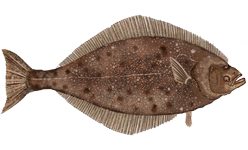
Hippoglossus stenolepis, the Pacific halibut, is a species of righteye flounder. This very large species of flatfish is native to the North Pacific and is fished by commercial fisheries, sport fishers, and subsistence fishers.

The yellowbelly flounder is a flatfish of the genus Rhombosolea, found around New Zealand. A different species from the genus Rhombosolea is found in Australia and also goes by the name yellow-belly flounder. The Māori people have commonly fished for R. leporina, and many other species of flatfish, throughout New Zealand's coastal waters for hundreds of years. The Māori name for this species is pātiki tōtara.
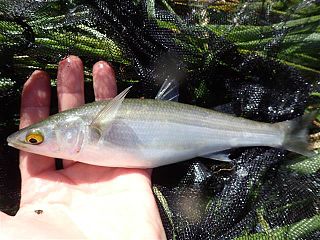
Yellow-eye mullet, also known as Coorong mullet, conmuri, estuary mullet, Forster's mullet, freshwater mullet, pilch, pilchard, Victor Harbor mullet, yelloweye, yellow-eyed mullet known are small, near-shore fish found in temperate waters of southern Australia from just north of Sydney, New South Wales to Shark Bay in Western Australia, around Tasmania, and New Zealand.
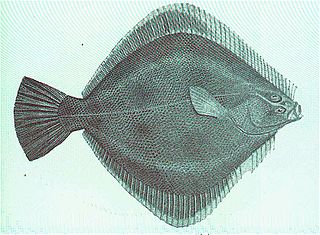
The New Zealand sand flounder is a righteye flounder of the genus Rhombosolea, found around New Zealand in shallow waters down to depths of 100 m.

The leopard coral grouper, also known as the common coral trout, leopard coral trout, blue-dotted coral grouper or spotted coral grouper, is a species of marine ray-finned fish, a grouper from the subfamily Epinephelinae which is part of the family Serranidae, which also includes the anthias and sea basses. It is found in the Western Pacific Ocean.
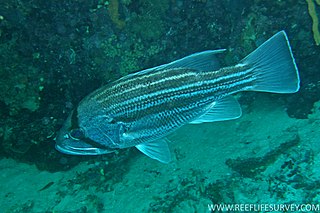
Glaucosoma hebraicum, the West Australian dhufish, Westralian jewfish, or West Australian pearl perch, is a species of fish in the family Glaucosomatidae, the pearl perches. It is endemic to the waters around Western Australia from Shark Bay, Western Australia, to the Archipelago of the Recherche at depths to 200 m (660 ft), though typically they occur at depths of 20–50 m (66–164 ft). This species is important to local commercial fisheries and is also popular as a game fish.

Dissostichus, the toothfish, is a genus of marine ray-finned fish belonging to the family Nototheniidae, the notothens or cod icefish. These fish are found in the Southern Hemisphere. Toothfish are marketed in the United States as Chilean sea bass or less frequently as white cod. "Chilean sea bass" is a marketing name coined in 1977 by Lee Lantz, a fish wholesaler who wanted a more attractive name for selling the Patagonian toothfish to Americans. In 1994, the U.S. Food and Drug Administration (FDA) accepted "Chilean sea bass" as an "alternative market name" for Patagonian toothfish. The toothfish was remarkably successful in the United States, Europe and Asia, and earned the nickname "white gold" within the market. Toothfish are vital to the ecological structure of Southern Ocean ecosystems. For this reason, on 4 September a national day is dedicated to the toothfish in South Georgia.

Coastal fish, also called inshore fish or neritic fish, inhabit the sea between the shoreline and the edge of the continental shelf. Since the continental shelf is usually less than 200 metres (660 ft) deep, it follows that pelagic coastal fish are generally epipelagic fish, inhabiting the sunlit epipelagic zone. Coastal fish can be contrasted with oceanic fish or offshore fish, which inhabit the deep seas beyond the continental shelves.

The mackerel icefish is a benthopelagic species of fish found in the Southern Ocean and the southernmost waters of the Atlantic Ocean. They are mainly to be found near Heard and McDonald Islands, Îles Kerguelen and islands in the south Atlantic such as South Georgia and Bouvet Island. The species also inhabits the northern waters of the Antarctic Peninsula. They live at depths of 0–700 metres (0–2,297 ft), but are commonly found at depths of 30 to 250 metres.

Nototodarus gouldi, also known as the Gould's squid, Gould's flying squid, or arrow squid, is a squid belonging to the family Ommastrephidae. It inhabits the tropical and temperate waters of Australia and New Zealand. It is frequently caught and eaten for food. They live up to one year.


















